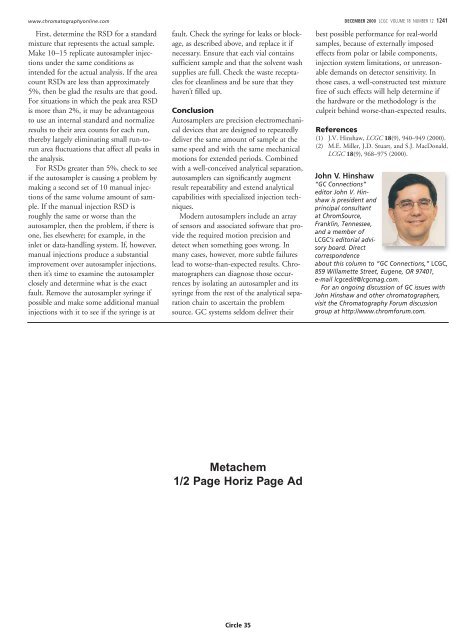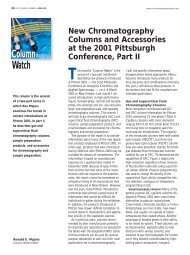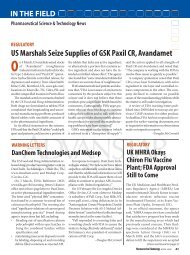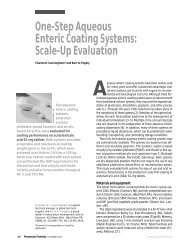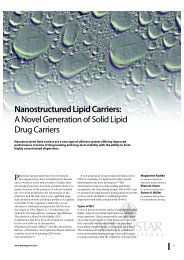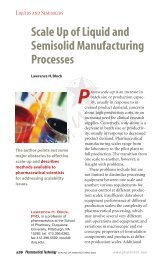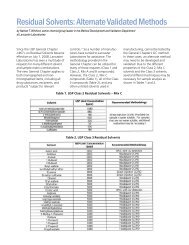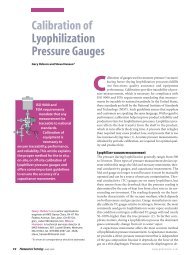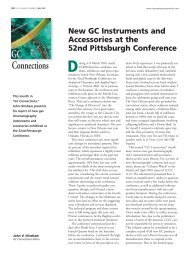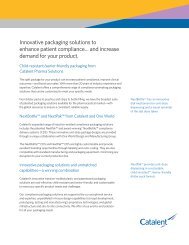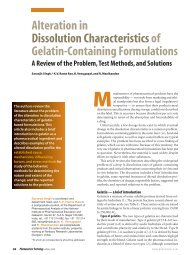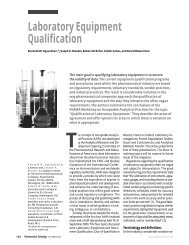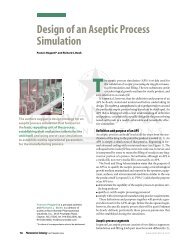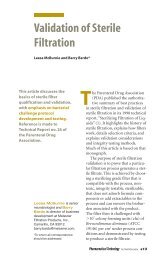Autosamplers - Chromatography Online
Autosamplers - Chromatography Online
Autosamplers - Chromatography Online
Create successful ePaper yourself
Turn your PDF publications into a flip-book with our unique Google optimized e-Paper software.
www.chromatographyonline.com<br />
First, determine the RSD for a standard<br />
mixture that represents the actual sample.<br />
Make 10–15 replicate autosampler injections<br />
under the same conditions as<br />
intended for the actual analysis. If the area<br />
count RSDs are less than approximately<br />
5%, then be glad the results are that good.<br />
For situations in which the peak area RSD<br />
is more than 2%, it may be advantageous<br />
to use an internal standard and normalize<br />
results to their area counts for each run,<br />
thereby largely eliminating small run-torun<br />
area fluctuations that affect all peaks in<br />
the analysis.<br />
For RSDs greater than 5%, check to see<br />
if the autosampler is causing a problem by<br />
making a second set of 10 manual injections<br />
of the same volume amount of sample.<br />
If the manual injection RSD is<br />
roughly the same or worse than the<br />
autosampler, then the problem, if there is<br />
one, lies elsewhere; for example, in the<br />
inlet or data-handling system. If, however,<br />
manual injections produce a substantial<br />
improvement over autosampler injections,<br />
then it’s time to examine the autosampler<br />
closely and determine what is the exact<br />
fault. Remove the autosampler syringe if<br />
possible and make some additional manual<br />
injections with it to see if the syringe is at<br />
fault. Check the syringe for leaks or blockage,<br />
as described above, and replace it if<br />
necessary. Ensure that each vial contains<br />
sufficient sample and that the solvent wash<br />
supplies are full. Check the waste receptacles<br />
for cleanliness and be sure that they<br />
haven’t filled up.<br />
Conclusion<br />
<strong>Autosamplers</strong> are precision electromechanical<br />
devices that are designed to repeatedly<br />
deliver the same amount of sample at the<br />
same speed and with the same mechanical<br />
motions for extended periods. Combined<br />
with a well-conceived analytical separation,<br />
autosamplers can significantly augment<br />
result repeatability and extend analytical<br />
capabilities with specialized injection techniques.<br />
Modern autosamplers include an array<br />
of sensors and associated software that provide<br />
the required motion precision and<br />
detect when something goes wrong. In<br />
many cases, however, more subtle failures<br />
lead to worse-than-expected results. Chromatographers<br />
can diagnose those occurrences<br />
by isolating an autosampler and its<br />
syringe from the rest of the analytical separation<br />
chain to ascertain the problem<br />
source. GC systems seldom deliver their<br />
DECEMBER 2000 LCGC VOLUME 18 NUMBER 12 1241<br />
best possible performance for real-world<br />
samples, because of externally imposed<br />
effects from polar or labile components,<br />
injection system limitations, or unreasonable<br />
demands on detector sensitivity. In<br />
those cases, a well-constructed test mixture<br />
free of such effects will help determine if<br />
the hardware or the methodology is the<br />
culprit behind worse-than-expected results.<br />
References<br />
(1) J.V. Hinshaw, LCGC 18(9), 940–949 (2000).<br />
(2) M.E. Miller, J.D. Stuart, and S.J. MacDonald,<br />
LCGC 18(9), 968–975 (2000).<br />
John V. Hinshaw<br />
“GC Connections”<br />
editor John V. Hinshaw<br />
is president and<br />
principal consultant<br />
at ChromSource,<br />
Franklin, Tennessee,<br />
and a member of<br />
LCGC’s editorial advisory<br />
board. Direct<br />
correspondence<br />
about this column to “GC Connections,” LCGC,<br />
859 Willamette Street, Eugene, OR 97401,<br />
e-mail lcgcedit@lcgcmag.com.<br />
For an ongoing discussion of GC issues with<br />
John Hinshaw and other chromatographers,<br />
visit the <strong>Chromatography</strong> Forum discussion<br />
group at http://www.chromforum.com.<br />
Metachem<br />
1/2 Page Horiz Page Ad<br />
Circle 35


